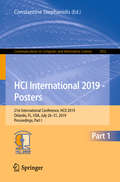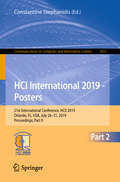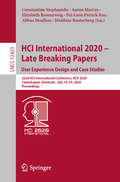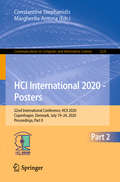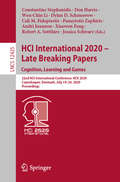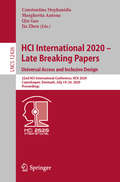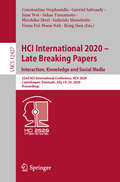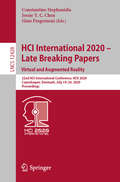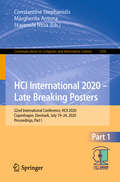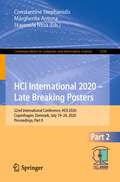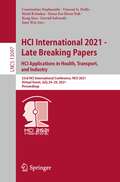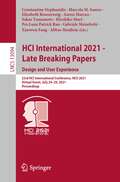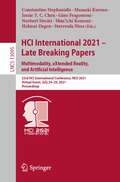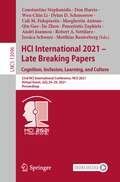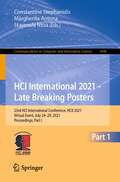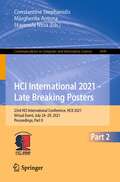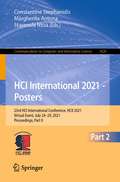- Table View
- List View
HCI International 2019 - Posters: 21st International Conference, HCII 2019, Orlando, FL, USA, July 26–31, 2019, Proceedings, Part I (Communications in Computer and Information Science #1032)
by Constantine StephanidisThe three-volume set CCIS 1032, CCIS 1033, and CCIS 1034 contains the extended abstracts of the posters presented during the 21st International Conference on Human-Computer Interaction, HCII 2019, which took place in Orlando, Florida, in July 2019.The total of 1274 papers and 209 posters included in the 35 HCII 2019 proceedings volumes was carefully reviewed and selected from 5029 submissions.The 208 papers presented in these three volumes are organized in topical sections as follows: Part I: design, development and evaluation methods and technique; multimodal Interaction; security and trust; accessibility and universal access; design and user experience case studies. Part II:interacting with games; human robot interaction; AI and machine learning in HCI; physiological measuring; object, motion and activity recognition; virtual and augmented reality; intelligent interactive environments. Part III: new trends in social media; HCI in business; learning technologies; HCI in transport and autonomous driving; HCI for health and well-being.
HCI International 2019 - Posters: 21st International Conference, HCII 2019, Orlando, FL, USA, July 26–31, 2019, Proceedings, Part II (Communications in Computer and Information Science #1033)
by Constantine StephanidisThe three-volume set CCIS 1032, CCIS 1033, and CCIS 1034 contains the extended abstracts of the posters presented during the 21st International Conference on Human-Computer Interaction, HCII 2019, which took place in Orlando, Florida, in July 2019.The total of 1274 papers and 209 posters included in the 35 HCII 2019 proceedings volumes was carefully reviewed and selected from 5029 submissions.The 208 papers presented in these three volumes are organized in topical sections as follows: Part I: design, development and evaluation methods and technique; multimodal Interaction; security and trust; accessibility and universal access; design and user experience case studies. Part II:interacting with games; human robot interaction; AI and machine learning in HCI; physiological measuring; object, motion and activity recognition; virtual and augmented reality; intelligent interactive environments. Part III: new trends in social media; HCI in business; learning technologies; HCI in transport and autonomous driving; HCI for health and well-being.
HCI International 2019 - Posters: 21st International Conference, HCII 2019, Orlando, FL, USA, July 26–31, 2019, Proceedings, Part III (Communications in Computer and Information Science #1034)
by Constantine StephanidisThe three-volume set CCIS 1032, CCIS 1033, and CCIS 1034 contains the extended abstracts of the posters presented during the 21st International Conference on Human-Computer Interaction, HCII 2019, which took place in Orlando, Florida, in July 2019.The total of 1274 papers and 209 posters included in the 35 HCII 2019 proceedings volumes was carefully reviewed and selected from 5029 submissions.The 208 papers presented in these three volumes are organized in topical sections as follows: Part I: design, development and evaluation methods and technique; multimodal Interaction; security and trust; accessibility and universal access; design and user experience case studies. Part II:interacting with games; human robot interaction; AI and machine learning in HCI; physiological measuring; object, motion and activity recognition; virtual and augmented reality; intelligent interactive environments. Part III: new trends in social media; HCI in business; learning technologies; HCI in transport and autonomous driving; HCI for health and well-being.
HCI International 2019 – Late Breaking Papers: 21st HCI International Conference, HCII 2019, Orlando, FL, USA, July 26–31, 2019, Proceedings (Lecture Notes in Computer Science #11786)
by Constantine StephanidisThis year the 21st International Conference on Human-Computer Interaction, HCII 2019, which was held in Orlando, Florida, USA, in July 2019, introduced the additional option of "late-breaking work", which applied both for papers and posters with the corresponding volumes of the proceedings. The 47 late-breaking papers included in this volume were published after the conference has taken place. They were organized in the following topical sections: user experience design and evaluation; information, visualization, and decision making; virtual and augmented reality; learning and games; human and task models in HCI; and design and user experience case studies.
HCI International 2019 – Late Breaking Posters: 21st HCI International Conference, HCII 2019, Orlando, FL, USA, July 26–31, 2019, Proceedings (Communications in Computer and Information Science #1088)
by Margherita Antona Constantine StephanidisThis book constitutes the extended abstracts of the posters presented during the 21st International Conference on Human-Computer Interaction, HCII 2019, which took place in Orlando, Florida, in July 2019. The total of 1274 papers and 209 posters included in the 35 HCII 2019 proceedings volumes was carefully reviewed and selected from 5029 submissions. The 55 papers presented in this volume are organized in topical sections as follows: interaction design; cognitive issues in HCI; accessibility and universal access; learning and games; HCI in health and rehabilitation; HCI in business and society; big data, machine learning and visual analytics; and user studies.
HCI International 2020 - Late Breaking Papers: 22nd HCI International Conference, HCII 2020, Copenhagen, Denmark, July 19–24, 2020, Proceedings (Lecture Notes in Computer Science #12423)
by Aaron Marcus Constantine Stephanidis Pei-Luen Patrick Rau Matthias Rauterberg Abbas Moallem Elizabeth RosenzweigThis book constitutes late breaking papers from the 22nd International Conference on Human-Computer Interaction, HCII 2020, which was held in July 2020. The conference was planned to take place in Copenhagen, Denmark, but had to change to a virtual conference mode due to the COVID-19 pandemic.From a total of 6326 submissions, a total of 1439 papers and 238 posters have been accepted for publication in the HCII 2020 proceedings before the conference took place. In addition, a total of 333 papers and 144 posters are included in the volumes of the proceedings published after the conference as “Late Breaking Work” (papers and posters). These contributions address the latest research and development efforts in the field and highlight the human aspects of design and use of computing systems. The 54 late breaking papers presented in this volume were organized in two topical sections named: User Experience Design and Evaluation Methods and Tools; Design Case Studies; User Experience Case Studies.
HCI International 2020 - Late Breaking Papers: 22nd HCI International Conference, HCII 2020, Copenhagen, Denmark, July 19–24, 2020, Proceedings (Lecture Notes in Computer Science #12424)
by Masaaki Kurosu Constantine Stephanidis Lauren Reinerman-Jones Helmut DegenThis book constitutes late breaking papers from the 22nd International Conference on Human-Computer Interaction, HCII 2020, which was held in July 2020. The conference was planned to take place in Copenhagen, Denmark, but had to change to a virtual conference mode due to the COVID-19 pandemic.From a total of 6326 submissions, a total of 1439 papers and 238 posters have been accepted for publication in the HCII 2020 proceedings before the conference took place. In addition, a total of 333 papers and 144 posters are included in the volumes of the proceedings published after the conference as “Late Breaking Work” (papers and posters). These contributions address the latest research and development efforts in the field and highlight the human aspects of design and use of computing systems.
HCI International 2020 - Posters: 22nd International Conference, HCII 2020, Copenhagen, Denmark, July 19–24, 2020, Proceedings, Part I (Communications in Computer and Information Science #1224)
by Margherita Antona Constantine StephanidisThe three-volume set CCIS 1224, CCIS 1225, and CCIS 1226 contains the extended abstracts of the posters presented during the 21st International Conference on Human-Computer Interaction, HCII 2020, which took place in Copenhagen, Denmark, in July 2020.* HCII 2020 received a total of 6326 submissions, of which 1439 papers and 238 posters were accepted for publication in the pre-conference proceedings after a careful reviewing process. The 238 papers presented in these three volumes are organized in topical sections as follows: Part I: design and evaluation methods and tools; user characteristics, requirements and preferences; multimodal and natural interaction; recognizing human psychological states; user experience studies; human perception and cognition. -AI in HCI. Part II: virtual, augmented and mixed reality; virtual humans and motion modelling and tracking; learning technology. Part III: universal access, accessibility and design for the elderly; smartphones, social media and human behavior; interacting with cultural heritage; human-vehicle interaction; transport, safety and crisis management; security, privacy and trust; product and service design. *The conference was held virtually due to the COVID-19 pandemic.
HCI International 2020 - Posters: 22nd International Conference, HCII 2020, Copenhagen, Denmark, July 19–24, 2020, Proceedings, Part II (Communications in Computer and Information Science #1225)
by Margherita Antona Constantine StephanidisThe three-volume set CCIS 1224, CCIS 1225, and CCIS 1226 contains the extended abstracts of the posters presented during the 21st International Conference on Human-Computer Interaction, HCII 2020, which took place in Copenhagen, Denmark, in July 2020.* HCII 2020 received a total of 6326 submissions, of which 1439 papers and 238 posters were accepted for publication in the pre-conference proceedings after a careful reviewing process. The 238 papers presented in these three volumes are organized in topical sections as follows: Part I: design and evaluation methods and tools; user characteristics, requirements and preferences; multimodal and natural interaction; recognizing human psychological states; user experience studies; human perception and cognition. -AI in HCI. Part II: virtual, augmented and mixed reality; virtual humans and motion modelling and tracking; learning technology. Part III: universal access, accessibility and design for the elderly; smartphones, social media and human behavior; interacting with cultural heritage; human-vehicle interaction; transport, safety and crisis management; security, privacy and trust; product and service design. *The conference was held virtually due to the COVID-19 pandemic. The chapter "“Developing an Interactive Tabletop Mediated Activity to Induce Collaboration by Implementing Design Considerations Based on Cooperative Learning Principles” is available open access under a Creative Commons Attribution 4.0 International License via link.springer.com.
HCI International 2020 - Posters: 22nd International Conference, HCII 2020, Copenhagen, Denmark, July 19–24, 2020, Proceedings, Part III (Communications in Computer and Information Science #1226)
by Margherita Antona Constantine StephanidisThe three-volume set CCIS 1224, CCIS 1225, and CCIS 1226 contains the extended abstracts of the posters presented during the 21st International Conference on Human-Computer Interaction, HCII 2020, which took place in Copenhagen, Denmark, in July 2020.* HCII 2020 received a total of 6326 submissions, of which 1439 papers and 238 posters were accepted for publication in the pre-conference proceedings after a careful reviewing process. The 238 papers presented in these three volumes are organized in topical sections as follows: Part I: design and evaluation methods and tools; user characteristics, requirements and preferences; multimodal and natural interaction; recognizing human psychological states; user experience studies; human perception and cognition. -AI in HCI. Part II: virtual, augmented and mixed reality; virtual humans and motion modelling and tracking; learning technology. Part III: universal access, accessibility and design for the elderly; smartphones, social media and human behavior; interacting with cultural heritage; human-vehicle interaction; transport, safety and crisis management; security, privacy and trust; product and service design. *The conference was held virtually due to the COVID-19 pandemic.
HCI International 2020 – Late Breaking Papers: 22nd HCI International Conference, HCII 2020, Copenhagen, Denmark, July 19–24, 2020, Proceedings (Lecture Notes in Computer Science #12425)
by Dylan D. Schmorrow Cali M. Fidopiastis Constantine Stephanidis Don Harris Panayiotis Zaphiris Andri Ioannou Jessica Schwarz Robert A. Sottilare Xiaowen Fang Wen-Chin LiThis book constitutes late breaking papers from the 22nd International Conference on Human-Computer Interaction, HCII 2020, which was held in July 2020. The conference was planned to take place in Copenhagen, Denmark, but had to change to a virtual conference mode due to the COVID-19 pandemic.From a total of 6326 submissions, a total of 1439 papers and 238 posters have been accepted for publication in the HCII 2020 proceedings before the conference took place. In addition, a total of 333 papers and 144 posters are included in the volumes of the proceedings published after the conference as “Late Breaking Work” (papers and posters). These contributions address the latest research and development efforts in the field and highlight the human aspects of design and use of computing systems.
HCI International 2020 – Late Breaking Papers: 22nd HCI International Conference, HCII 2020, Copenhagen, Denmark, July 19–24, 2020, Proceedings (Lecture Notes in Computer Science #12426)
by Jia Zhou Margherita Antona Constantine Stephanidis Qin GaoThis book constitutes late breaking papers from the 22nd International Conference on Human-Computer Interaction, HCII 2020, which was held in July 2020. The conference was planned to take place in Copenhagen, Denmark, but had to change to a virtual conference mode due to the COVID-19 pandemic.From a total of 6326 submissions, a total of 1439 papers and 238 posters have been accepted for publication in the HCII 2020 proceedings before the conference took place. In addition, a total of 333 papers and 144 posters are included in the volumes of the proceedings published after the conference as “Late Breaking Work” (papers and posters). These contributions address the latest research and development efforts in the field and highlight the human aspects of design and use of computing systems. The 59 late breaking papers presented in this volume address the latest research and development efforts in the field and highlight the human aspects of design and use of computing systems.
HCI International 2020 – Late Breaking Papers: 22nd HCI International Conference, HCII 2020, Copenhagen, Denmark, July 19–24, 2020, Proceedings (Lecture Notes in Computer Science #12427)
by Gavriel Salvendy Gabriele Meiselwitz Fiona Fui-Hoon Nah Constantine Stephanidis Sakae Yamamoto Hirohiko Mori June Wei Keng SiauThis book constitutes late breaking papers from the 22nd International Conference on Human-Computer Interaction, HCII 2020, which was held in July 2020. The conference was planned to take place in Copenhagen, Denmark, but had to change to a virtual conference mode due to the COVID-19 pandemic.From a total of 6326 submissions, a total of 1439 papers and 238 posters have been accepted for publication in the HCII 2020 proceedings before the conference took place. In addition, a total of 333 papers and 144 posters are included in the volumes of the proceedings published after the conference as “Late Breaking Work” (papers and posters). These contributions address the latest research and development efforts in the field and highlight the human aspects of design and use of computing systems. The 54 late breaking papers address topics such as Interaction, Knowledge and Social Media.
HCI International 2020 – Late Breaking Papers: 22nd HCI International Conference, HCII 2020, Copenhagen, Denmark, July 19–24, 2020, Proceedings (Lecture Notes in Computer Science #12428)
by Constantine Stephanidis Gino Fragomeni Jessie Y. C. ChenThis book constitutes late breaking papers from the 22nd International Conference on Human-Computer Interaction, HCII 2020, which was held in July 2020. The conference was planned to take place in Copenhagen, Denmark, but had to change to a virtual conference mode due to the COVID-19 pandemic.From a total of 6326 submissions, a total of 1439 papers and 238 posters have been accepted for publication in the HCII 2020 proceedings before the conference took place. In addition, a total of 333 papers and 144 posters are included in the volumes of the proceedings published after the conference as “Late Breaking Work” (papers and posters). These contributions address the latest research and development efforts in the field and highlight the human aspects of design and use of computing systems. The 34 late breaking papers presented in this volume were organized in two topical sections named: Virtual, Augmented and Mixed Reality Design and Implementation; and User Experience in Virtual, Augmented and Mixed Reality.
HCI International 2020 – Late Breaking Papers: 22nd HCI International Conference, HCII 2020, Copenhagen, Denmark, July 19–24, 2020, Proceedings (Lecture Notes in Computer Science #12429)
by Constantine Stephanidis Norbert Streitz Vincent G. Duffy Shin’ichi Konomi Heidi KrömkerThis book constitutes late breaking papers from the 22nd International Conference on Human-Computer Interaction, HCII 2020, which was held in July 2020. The conference was planned to take place in Copenhagen, Denmark, but had to change to a virtual conference mode due to the COVID-19 pandemic. From a total of 6326 submissions, a total of 1439 papers and 238 posters have been accepted for publication in the HCII 2020 proceedings before the conference took place. In addition, a total of 333 papers and 144 posters are included in the volumes of the proceedings published after the conference as “Late Breaking Work” (papers and posters). These contributions address the latest research and development efforts in the field and highlight the human aspects of design and use of computing systems. The 42 late breaking papers presented in this volume were organized in topical sections as follows: HCI in Automotive; Interaction in Intelligent Environments; and Digital Human Modeling and Ergonomics.
HCI International 2020 – Late Breaking Posters: 22nd International Conference, HCII 2020, Copenhagen, Denmark, July 19–24, 2020, Proceedings, Part I (Communications in Computer and Information Science #1293)
by Margherita Antona Constantine Stephanidis Stavroula NtoaThis book constitutes the poster papers presented during the 22nd International Conference on Human-Computer Interaction, HCII 2020, which was held in July 2020. The conference was planned to take place in Copenhagen, Denmark, but had to change to a virtual conference mode due to the COVID-19 pandemic.From a total of 6326 submissions, a total of 1439 papers and 238 posters have been accepted for publication in the HCII 2020 proceedings before the conference took place. In addition, a total of 333 papers and 144 posters are included in the volumes of the proceedings published after the conference as “Late Breaking Work” (papers and posters). These contributions address the latest research and development efforts in the field and highlight the human aspects of design and use of computing systems.The 62 papers presented in this volume are organized in topical sections as follows: HCI theory, methods and tools; mobile and multimodal interaction; interacting with data, information and knowledge; interaction and intelligence; user experience, emotions and psychophysiological computing.
HCI International 2020 – Late Breaking Posters: 22nd International Conference, HCII 2020, Copenhagen, Denmark, July 19–24, 2020, Proceedings, Part II (Communications in Computer and Information Science #1294)
by Margherita Antona Constantine Stephanidis Stavroula NtoaThis book constitutes the extended abstracts of the posters presented during the 22nd International Conference on Human-Computer Interaction, HCII 2020, which was held in July 2020. The conference was planned to take place in Copenhagen, Denmark, but had to change to a virtual conference mode due to the COVID-19 pandemic.From a total of 6326 submissions, a total of 1439 papers and 238 posters have been accepted for publication in the HCII 2020 proceedings before the conference took place. In addition, a total of 333 papers and 144 posters are included in the volumes of the proceedings published after the conference as “Late Breaking Work” (papers and posters). These contributions address the latest research and development efforts in the field and highlight the human aspects of design and use of computing systems.The 82 papers presented in this volume are organized in topical sections as follows: design for all and sssisitive technologies; virtual, augmented and mixed reality; learning; HCI, culture and art; health and wellbeing applications; HCI in mobility, automotive and aviation.
HCI International 2021 - Late Breaking Papers: 23rd HCI International Conference, HCII 2021, Virtual Event, July 24–29, 2021 Proceedings (Lecture Notes in Computer Science #13097)
by Gavriel Salvendy Fiona Fui-Hoon Nah Constantine Stephanidis Vincent G. Duffy June Wei Heidi Krömker Keng SiauThis book constitutes late breaking papers from the 23rd International Conference on Human-Computer Interaction, HCII 2021, which was held in July 2021. The conference was planned to take place in Washington DC, USA but had to change to a virtual conference mode due to the COVID-19 pandemic. A total of 5222 individuals from academia, research institutes, industry, and governmental agencies from 81 countries submitted contributions, and 1276 papers and 241 posters were included in the volumes of the proceedings that were published before the start of the conference. Additionally, 174 papers and 146 posters are included in the volumes of the proceedings published after the conference, as “Late Breaking Work” (papers and posters). The contributions thoroughly cover the entire field of HCI, addressing major advances in knowledge and effective use of computers in a variety of application areas.
HCI International 2021 - Late Breaking Papers: 23rd HCI International Conference, HCII 2021, Virtual Event, July 24–29, 2021, Proceedings (Lecture Notes in Computer Science #13094)
by Aaron Marcus Gabriele Meiselwitz Constantine Stephanidis Sakae Yamamoto Pei-Luen Patrick Rau Hirohiko Mori Marcelo M. Soares Abbas Moallem Xiaowen Fang Elizabeth RosenzweigThis book constitutes late breaking papers from the 23rd International Conference on Human-Computer Interaction, HCII 2021, which was held in July 2021. The conference was planned to take place in Washington DC, USA but had to change to a virtual conference mode due to the COVID-19 pandemic. A total of 5222 individuals from academia, research institutes, industry, and governmental agencies from 81 countries submitted contributions, and 1276 papers and 241 posters were included in the volumes of the proceedings that were published before the start of the conference. Additionally, 174 papers and 146 posters are included in the volumes of the proceedings published after the conference, as “Late Breaking Work” (papers and posters). The contributions thoroughly cover the entire field of HCI, addressing major advances in knowledge and effective use of computers in a variety of application areas.
HCI International 2021 - Late Breaking Papers: 23rd HCI International Conference, HCII 2021, Virtual Event, July 24–29, 2021, Proceedings (Lecture Notes in Computer Science #13095)
by Masaaki Kurosu Constantine Stephanidis Norbert Streitz Shin’ichi Konomi Gino Fragomeni Jessie Y. C. Chen Helmut Degen Stavroula NtoaThis book constitutes late breaking papers from the 23rd International Conference on Human-Computer Interaction, HCII 2021, which was held in July 2021. The conference was planned to take place in Washington DC, USA but had to change to a virtual conference mode due to the COVID-19 pandemic. A total of 5222 individuals from academia, research institutes, industry, and governmental agencies from 81 countries submitted contributions, and 1276 papers and 241 posters were included in the volumes of the proceedings that were published before the start of the conference. Additionally, 174 papers and 146 posters are included in the volumes of the proceedings published after the conference, as “Late Breaking Work” (papers and posters). The contributions thoroughly cover the entire field of HCI, addressing major advances in knowledge and effective use of computers in a variety of application areas.
HCI International 2021 - Late Breaking Papers: 23rd HCI International Conference, HCII 2021, Virtual Event, July 24–29, 2021, Proceedings (Lecture Notes in Computer Science #13096)
by Jia Zhou Dylan D. Schmorrow Cali M. Fidopiastis Margherita Antona Constantine Stephanidis Don Harris Panayiotis Zaphiris Andri Ioannou Matthias Rauterberg Jessica Schwarz Robert A. Sottilare Wen-Chin Li Qin GaoThis book constitutes late breaking papers from the 23rd International Conference on Human-Computer Interaction, HCII 2021, which was held in July 2021. The conference was planned to take place in Washington DC, USA but had to change to a virtual conference mode due to the COVID-19 pandemic. A total of 5222 individuals from academia, research institutes, industry, and governmental agencies from 81 countries submitted contributions, and 1276 papers and 241 posters were included in the volumes of the proceedings that were published before the start of the conference. Additionally, 174 papers and 146 posters are included in the volumes of the proceedings published after the conference, as “Late Breaking Work” (papers and posters). The contributions thoroughly cover the entire field of HCI, addressing major advances in knowledge and effective use of computers in a variety of application areas.
HCI International 2021 - Late Breaking Posters: 23rd HCI International Conference, HCII 2021, Virtual Event, July 24–29, 2021, Proceedings, Part I (Communications in Computer and Information Science #1498)
by Margherita Antona Constantine Stephanidis Stavroula NtoaThis two-volume set CCIS 1498 and CCIS 1499 contains the late breaking posters presented during the 23rd International Conference on Human-Computer Interaction, HCII 2021, which was held virtually in July 2021. The total of 1276 papers and 241 posters included in the 39 HCII 2021 proceedings volumes was carefully reviewed and selected from 5222 submissions. Additionally, 174 papers and 146 posters are included in the volumes of the proceedings published after the conference, as “Late Breaking Work” (papers and posters). The posters presented in these two volumes are organized in topical sections as follows: HCI Theory and Practice; UX Design and Research in Intelligent Environments; Interaction with Robots, Chatbots, and Agents; Virtual, Augmented, and Mixed Reality; Games and Gamification; HCI in Mobility, Transport and Aviation; Design for All and Assistive Technologies; Physiology, Affect and Cognition; HCI for Health and Wellbeing; HCI in Learning, Teaching, and Education; Culture and Computing; Social Computing; Design Case Studies; User Experience Studies.
HCI International 2021 - Late Breaking Posters: 23rd HCI International Conference, HCII 2021, Virtual Event, July 24–29, 2021, Proceedings, Part II (Communications in Computer and Information Science #1499)
by Margherita Antona Constantine Stephanidis Stavroula NtoaThis two-volume set CCIS 1498 and CCIS 1499 contains the late breaking posters presented during the 23rd International Conference on Human-Computer Interaction, HCII 2021, which was held virtually in July 2021. The total of 1276 papers and 241 posters included in the 39 HCII 2021 proceedings volumes was carefully reviewed and selected from 5222 submissions. Additionally, 174 papers and 146 posters are included in the volumes of the proceedings published after the conference, as “Late Breaking Work” (papers and posters). The posters presented in these two volumes are organized in topical sections as follows: HCI Theory and Practice; UX Design and Research in Intelligent Environments; Interaction with Robots, Chatbots, and Agents; Virtual, Augmented, and Mixed Reality; Games and Gamification; HCI in Mobility, Transport and Aviation; Design for All and Assistive Technologies; Physiology, Affect and Cognition; HCI for Health and Wellbeing; HCI in Learning, Teaching, and Education; Culture and Computing; Social Computing; Design Case Studies; User Experience Studies.
HCI International 2021 - Posters: 23rd HCI International Conference, HCII 2021, Virtual Event, July 24–29, 2021, Proceedings, Part I (Communications in Computer and Information Science #1419)
by Margherita Antona Constantine Stephanidis Stavroula NtoaThe three-volume set CCIS 1419, CCIS 1420, and CCIS 1421 contains the extended abstracts of the posters presented during the 23rd International Conference on Human-Computer Interaction, HCII 2021, which was held virtually in July 2021. HCII 2021 received a total of 6326 submissions, of which 1439 papers and 238 posters were accepted for publication in the pre-conference proceedings after a careful reviewing process.The 238 poster papers presented in these three volumes are organized in topical sections as follows: Part I: HCI theory and methods; perceptual, cognitive and psychophisiological aspects of interaction; designing for children; designing for older people; design case studies; dimensions of user experience; information, language, culture and media. Part II: interaction methods and techniques; eye-tracking and facial expressions recognition; human-robot interaction; virtual, augmented and mixed reality; sand privacy issues in HCI; AI and machine learning in HCI. Part III: interacting and learning; interacting and playing; interacting and driving; digital wellbeing, eHealth and mHealth; interacting and shopping; HCI, safety and sustainability; HCI in the time of pandemic.Chapter "”X-8”: an Experimental Interactive Toy to Support Turn-Taking Games in Children with Autism Spectrum Disorders" is published open access under a CC BY license (Creative Commons Attribution 4.0 International License).
HCI International 2021 - Posters: 23rd HCI International Conference, HCII 2021, Virtual Event, July 24–29, 2021, Proceedings, Part II (Communications in Computer and Information Science #1420)
by Margherita Antona Constantine Stephanidis Stavroula NtoaThe three-volume set CCIS 1419, CCIS 1420, and CCIS 1421 contains the extended abstracts of the posters presented during the 23rd International Conference on Human-Computer Interaction, HCII 2021, which was held virtually in July 2021. HCII 2021 received a total of 6326 submissions, of which 1439 papers and 238 posters were accepted for publication in the pre-conference proceedings after a careful reviewing process.The 238 poster papers presented in these three volumes are organized in topical sections as follows: Part I: HCI theory and methods; perceptual, cognitive and psychophisiological aspects of interaction; designing for children; designing for older people; design case studies; dimensions of user experience; information, language, culture and media. Part II: interaction methods and techniques; eye-tracking and facial expressions recognition; human-robot interaction; virtual, augmented and mixed reality; sand privacy issues in HCI; AI and machine learning in HCI. Part III: interacting and learning; interacting and playing; interacting and driving; digital wellbeing, eHealth and mHealth; interacting and shopping; HCI, safety and sustainability; HCI in the time of pandemic.
